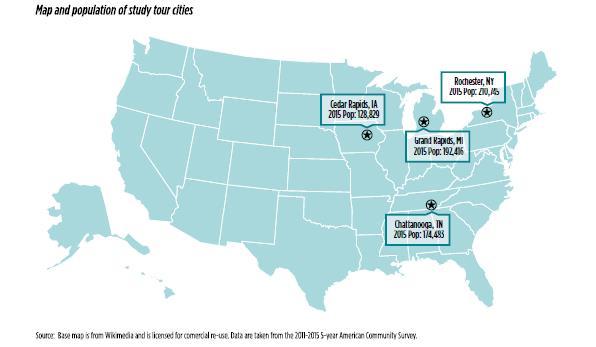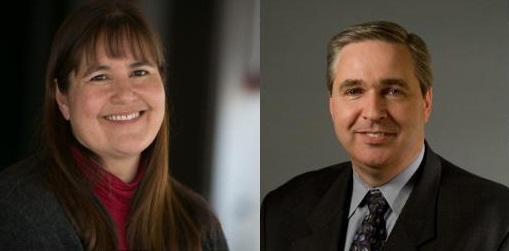Place-based funders can play an important role in connecting economic growth to opportunity.
What began as an inquiry into four small legacy cities – Chattanooga, Tenn.; Cedar Rapids, Iowa; Rochester, N.Y.; and Grand Rapids, Mich. – that appeared to have experienced some measure of revitalization in the post Great Recession environment, evolved into an understanding that the places are moving along two distinct paths: an “arc of growth” and an “arc of opportunity.” In the context of these small legacy cities, growth and opportunity unfold simultaneously along these two long-term and distinct “arcs” leading to the conclusion that broad community prosperity lies in (1) recognizing that growth alone does not naturally lead to opportunity and (2) advancing deliberate policies, investments, and programs that connect growth to opportunity.
Looking for Progress in America’s Smaller Legacy Cities: A Report for Place-based Funders looks at four cities and how place-based funders are helping in post-recession economic recovery. (Download the full publication here.)
Five Takeaways
Given the common narratives emerging from the study tour and the dual arcs framework for evaluating place-based revitalization, participants in the tour put forward a short, non-exhaustive, list of conclusions for funders:
1. Patient capital builds local capacity: The time horizons of community revitalization require capital that seeks both social impact and financial return over a longer-term. Place based funders are uniquely positioned to address the long time horizon that this work dictates, and the resources they control may be critical aspects in its acceleration or deceleration.
2. State policy often limits the flexibility and authority of local leaders to connect the arcs of growth and opportunity: Funders can take an active role in identifying those policy bottlenecks or opportunities that facilitate more positive local action toward connecting growth to opportunity. Place-based funders can be catalytic change agents for both policy and practice without engaging in lobbying.
3. Jurisdictional authorities dictate policy to connect the growth and opportunity arcs: The levers of power and resource allocations accorded to any number of public or pseudo-public authorities have a significant, often negative impact on the efficacy of efforts to connect the dual arcs. Funders can take an active role in helping to identify and break down or circumnavigate local jurisdictional boundaries that prevent positive action and facilitate alignment toward common goals.
4. Effective marketing and communication advances positive momentum: Maintaining a steady cadence on the long-term mission of community revitalization often falls to place-based leaders. In most cases, the community foundation or another place-rooted funder had a role in funding or otherwise supporting the narrative of a community’s recovery, articulating a common, inclusive vision of what is possible.
5. Accountability is the lynch pin for connecting the arcs: Cities around the country (including the four visited) have revitalized in various ways over the last several decades. But benefits of that growth have left many behind. Place-based funders should be strategic in holding local stakeholders accountable for connecting the growth and opportunity arcs.

Helpful Tools
Despite the challenges of connecting the arcs, multiple tools or approaches in which the local place-based foundation played a lead role as a funder, convener or ‘steward’ of the effort that may be valuable to other communities were noted. These tools were observed within a local context, and were often part of a broadly articulated plan or vision. While tools are helpful, the environment in which they are most likely to succeed is also important.
• Addressing concentrated poverty by place: Interventions in this category were geographically targeted, but multi-faceted and cross-generational. Stressed communities that were located near resources – perhaps transportation or a good school – were seen as good places to start.
• Addressing concentrated poverty through policy: Interventions in this category were explicit in channeling more gains from growth to opportunity, through local policy either by removing barriers or being prescriptive in the intentional distribution of benefits.
• Revitalizing downtown with greater attention to preserving and increasing affordable housing: While investments in making communities more attractive by building downtown entertainment or “innovation” districts and increasing desirable amenities has increased property values and living costs, cities are facing the need for more affordable, family friendly housing options near emerging employment opportunities.
• Business recruitment led by business retention: Community economic growth strategies focused on strengthening existing businesses by recruiting businesses in their supply chain, placing retention and success of existing business as a higher priority than traditional recruitment alone. Coordinated workforce development was often key to this strategy.
• Develop leaders: Concern exists about where the next two generations of leaders will come from and how they will support broad-based collaborative efforts. Strong leaders in business, government and non-profits, are critical to building a regional approach to both arcs.
• Data collection: Data has played an important role in many of the cities visited. Data should be publicly available and granular enough to support neighborhood level understanding as well as robust enough to present an aggregated, comprehensive city – or MSA-wide — profile.
Local dynamics dictate the timing, sequence, and particularities of the interplay between growth and opportunity strategies. Revitalization efforts that recognize the dual arcs and plan for their meaningful integration are more likely to yield robust and lasting long-term results. Because place-based funders are so integrally linked to the history and prospects of the communities they serve, they have unique roles and responsibilities not only as funders, but as local institutions and innovators to make these linkages across place and time.
About the Authors

Alicia Kitsuse is Director of TFN’s Older Industrial Cities Program.
Jeremiah P. Boyle is Managing Director of Community and Economic Development for the Federal Reserve Bank of Chicago
Looking for Progress in America’s Smaller Legacy Cities: A Report for Place-based Funders
The Federal Reserve Banks of Atlanta, Boston, Chicago, and New York recently released, in partnership with The Funders’ Network, a whitepaper presenting findings from a four-city study tour of older, legacy cities.This blog is the first in an occasional series stemming from that report. Future installments will reflect the views of some of the place-based funders that collaborated with Federal Reserve staff in the study tour visits and the subsequent report. This initial blog features, as background, the executive summary of the report. The full report can be downloaded here.
